FIAT DUCATO 2012 Owner handbook (in English)
Manufacturer: FIAT, Model Year: 2012, Model line: DUCATO, Model: FIAT DUCATO 2012Pages: 287, PDF Size: 4.5 MB
Page 211 of 287
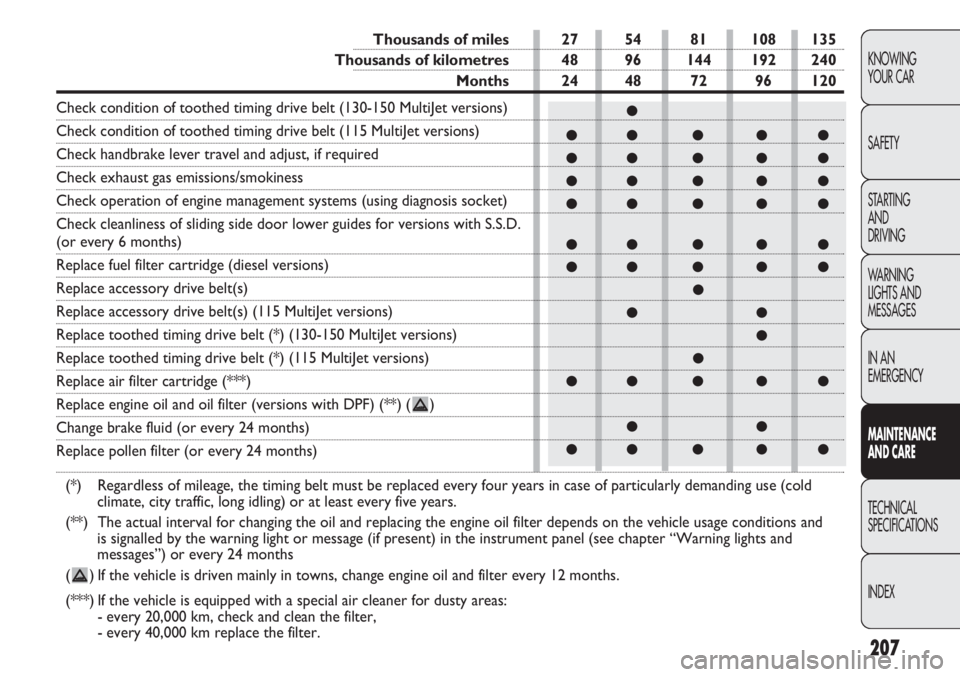
в—Џ
в—Џв—Џ в—Џ в—Џ в—Џ
в—Џв—Џ в—Џ в—Џ в—Џ
в—Џв—Џ в—Џ в—Џ в—Џ
в—Џв—Џ в—Џ в—Џ в—Џ
в—Џв—Џ в—Џ в—Џ в—Џ
в—Џв—Џ в—Џ в—Џ в—Џ
в—Џ
в—Џв—Џ
в—Џ
в—Џ
в—Џв—Џ в—Џ в—Џ в—Џ
в—Џв—Џ
в—Џв—Џ в—Џ в—Џ в—Џ
207
KNOWING
YOUR CAR
SAFETY
STARTING
AND
DRIVING
WARNING
LIGHTS AND
MESSAGES
IN AN
EMERGENCY
MAINTENANCE
AND CARE
TECHNICAL
SPECIFICATIONS
INDEX
Thousands of miles 27 54 81 108 135
Thousands of kilometres 48 96 144 192 240
Months 24 48 72 96 120
Check condition of toothed timing drive belt (130-150 MultiJet versions)
Check condition of toothed timing drive belt (115 MultiJet versions)
Check handbrake lever travel and adjust, if required
Check exhaust gas emissions/smokiness
Check operation of engine management systems (using diagnosis socket)
Check cleanliness of sliding side door lower guides for versions with S.S.D.
(or every 6 months)
Replace fuel filter cartridge (diesel versions)
Replace accessory drive belt(s)
Replace accessory drive belt(s) (115 MultiJet versions)
Replace toothed timing drive belt (*) (130-150 MultiJet versions)
Replace toothed timing drive belt (*) (115 MultiJet versions)
Replace air filter cartridge (***)
Replace engine oil and oil filter (versions with DPF) (**) ( )
Change brake fluid (or every 24 months)
Replace pollen filter (or every 24 months)
(*) Regardless of mileage, the timing belt must be replaced every four years in case of particularly demanding use (cold
climate, city traffic, long idling) or at least every five years.
(**) The actual interval for changing the oil and replacing the engine oil filter depends on the vehicle usage conditions and
is signalled by the warning light or message (if present) in the instrument panel (see chapter “Warning lights and
messages”) or every 24 months
( ) If the vehicle is driven mainly in towns, change engine oil and filter every 12 months.
(***) If the vehicle is equipped with a special air cleaner for dusty areas:
- every 20,000 km, check and clean the filter,
- every 40,000 km replace the filter.
Page 212 of 287
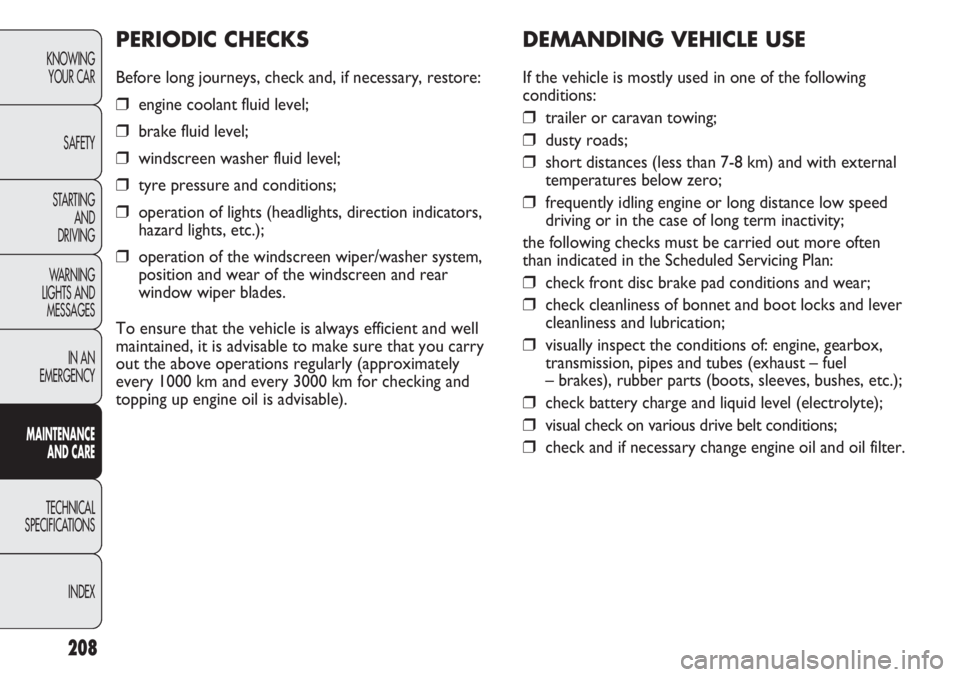
208
KNOWING
YOUR CAR
SAFETY
STARTING
AND
DRIVING
WARNING
LIGHTS AND
MESSAGES
IN AN
EMERGENCY
MAINTENANCE
AND CARE
TECHNICAL
SPECIFICATIONS
INDEX
DEMANDING VEHICLE USE
If the vehicle is mostly used in one of the following
conditions:
вќ’trailer or caravan towing;
вќ’dusty roads;
вќ’short distances (less than 7-8 km) and with external
temperatures below zero;
вќ’frequently idling engine or long distance low speed
driving or in the case of long term inactivity;
the following checks must be carried out more often
than indicated in the Scheduled Servicing Plan:
вќ’check front disc brake pad conditions and wear;
вќ’check cleanliness of bonnet and boot locks and lever
cleanliness and lubrication;
вќ’visually inspect the conditions of: engine, gearbox,
transmission, pipes and tubes (exhaust – fuel
– brakes), rubber parts (boots, sleeves, bushes, etc.);
вќ’check battery charge and liquid level (electrolyte);
вќ’visual check on various drive belt conditions;
вќ’check and if necessary change engine oil and oil filter.
PERIODIC CHECKS
Before long journeys, check and, if necessary, restore:
вќ’engine coolant fluid level;
вќ’brake fluid level;
вќ’windscreen washer fluid level;
вќ’tyre pressure and conditions;
вќ’operation of lights (headlights, direction indicators,
hazard lights, etc.);
вќ’operation of the windscreen wiper/washer system,
position and wear of the windscreen and rear
window wiper blades.
To ensure that the vehicle is always efficient and well
maintained, it is advisable to make sure that you carry
out the above operations regularly (approximately
every 1000 km and every 3000 km for checking and
topping up engine oil is advisable).
Page 213 of 287
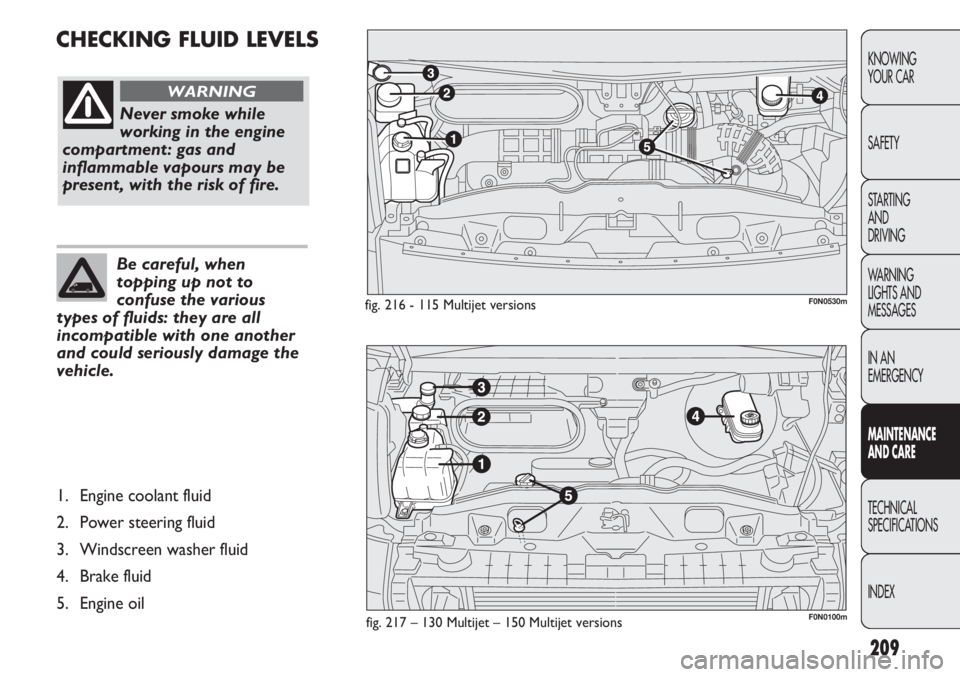
209
KNOWING
YOUR CAR
SAFETY
STARTING
AND
DRIVING
WARNING
LIGHTS AND
MESSAGES
IN AN
EMERGENCY
MAINTENANCE
AND CARE
TECHNICAL
SPECIFICATIONS
INDEX
CHECKING FLUID LEVELS
fig. 217 – 130 Multijet – 150 Multijet versions
Never smoke while
working in the engine
compartment: gas and
inflammable vapours may be
present, with the risk of fire.
WARNING
Be careful, when
topping up not to
confuse the various
types of fluids: they are all
incompatible with one another
and could seriously damage the
vehicle.
1. Engine coolant fluid
2. Power steering fluid
3. Windscreen washer fluid
4. Brake fluid
5. Engine oil
fig. 216 - 115 Multijet versionsF0N0530m
F0N0100m
Page 214 of 287
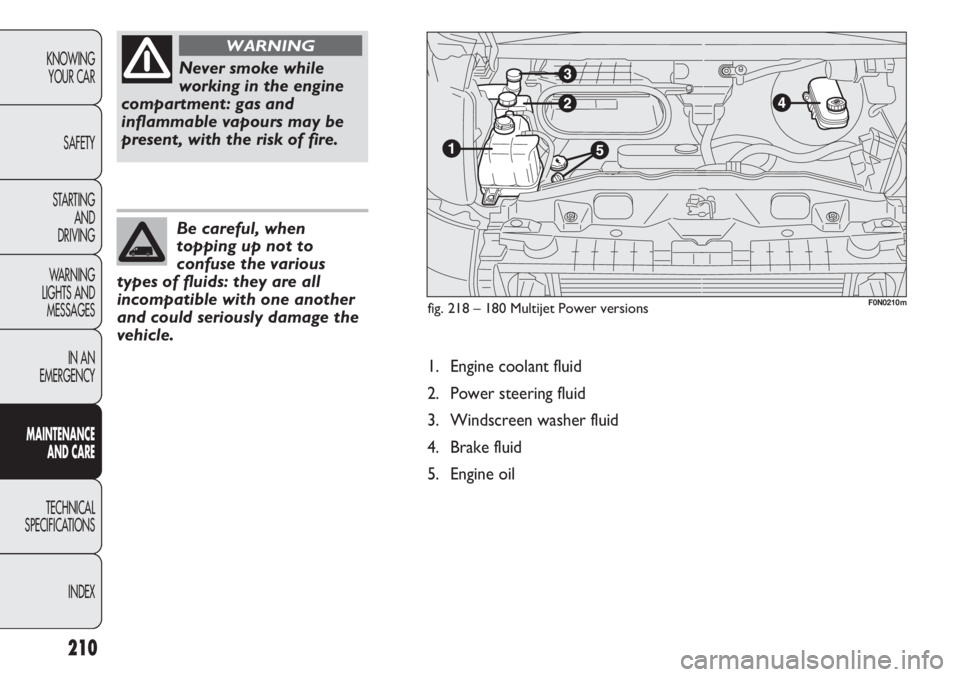
210
KNOWING
YOUR CAR
SAFETY
STARTING
AND
DRIVING
WARNING
LIGHTS AND
MESSAGES
IN AN
EMERGENCY
MAINTENANCE
AND CARE
TECHNICAL
SPECIFICATIONS
INDEX
Be careful, when
topping up not to
confuse the various
types of fluids: they are all
incompatible with one another
and could seriously damage the
vehicle.
1. Engine coolant fluid
2. Power steering fluid
3. Windscreen washer fluid
4. Brake fluid
5. Engine oil
fig. 218 – 180 Multijet Power versions
Never smoke while
working in the engine
compartment: gas and
inflammable vapours may be
present, with the risk of fire.
WARNING
F0N0210m
Page 215 of 287

211
KNOWING
YOUR CAR
SAFETY
STARTING
AND
DRIVING
WARNING
LIGHTS AND
MESSAGES
IN AN
EMERGENCY
MAINTENANCE
AND CARE
TECHNICAL
SPECIFICATIONS
INDEX
F0N0102mfig. 220 – 130 – 150 Multijet versionsF0N0211mfig. 221 – 180 Multijet Power versions
The range between the MIN. and MAX. marks
corresponds to about 1 litre of oil.
If the oil level is near or under the MIN line, add oil
through the filler A until it reaches the MAX line.
The oil level should never exceed the MAX line. ENGINE OIL fig. 219-220-221
Check the oil level a few minutes (about 5) after the
engine has stopped, with the vehicle parked on level
ground.
Check that the level is within the MIN and MAX marks
on the dipstick B.
F0N0531mfig. 219 - 115 Multijet versions
Page 216 of 287
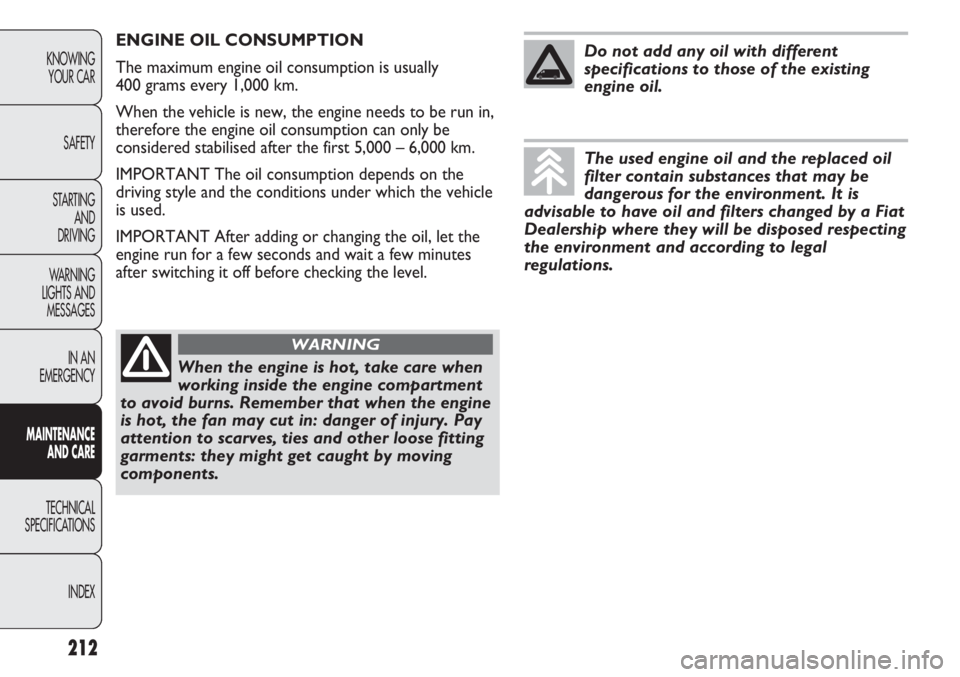
212
KNOWING
YOUR CAR
SAFETY
STARTING
AND
DRIVING
WARNING
LIGHTS AND
MESSAGES
IN AN
EMERGENCY
MAINTENANCE
AND CARE
TECHNICAL
SPECIFICATIONS
INDEX
ENGINE OIL CONSUMPTION
The maximum engine oil consumption is usually
400 grams every 1,000 km.
When the vehicle is new, the engine needs to be run in,
therefore the engine oil consumption can only be
considered stabilised after the first 5,000 – 6,000 km.
IMPORTANT The oil consumption depends on the
driving style and the conditions under which the vehicle
is used.
IMPORTANT After adding or changing the oil, let the
engine run for a few seconds and wait a few minutes
after switching it off before checking the level.
When the engine is hot, take care when
working inside the engine compartment
to avoid burns. Remember that when the engine
is hot, the fan may cut in: danger of injury. Pay
attention to scarves, ties and other loose fitting
garments: they might get caught by moving
components.
WARNING
Do not add any oil with different
specifications to those of the existing
engine oil.
The used engine oil and the replaced oil
filter contain substances that may be
dangerous for the environment. It is
advisable to have oil and filters changed by a Fiat
Dealership where they will be disposed respecting
the environment and according to legal
regulations.
Page 217 of 287
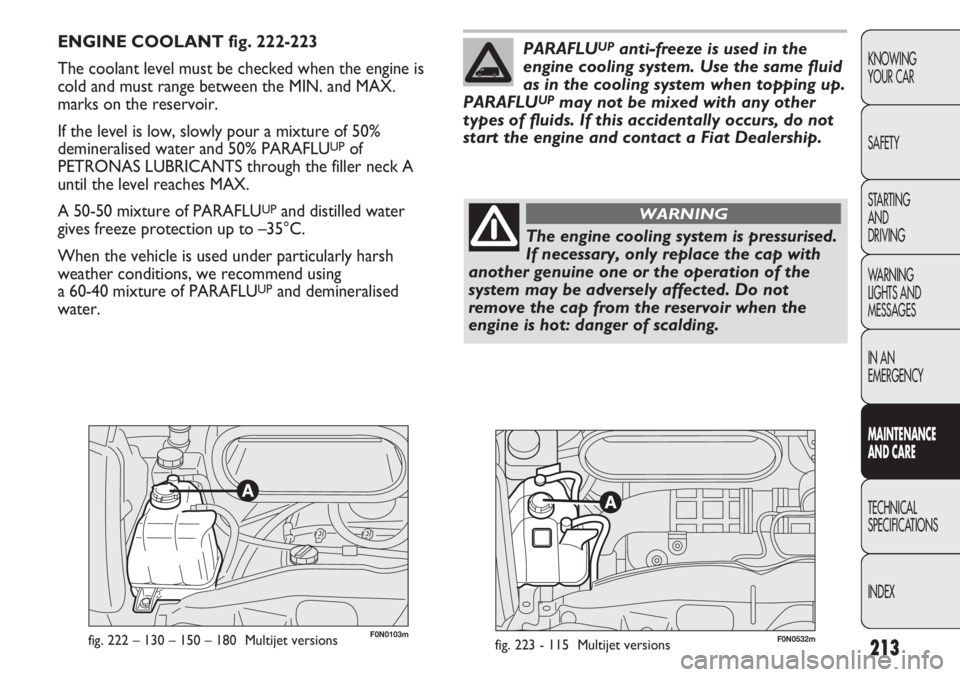
213
KNOWING
YOUR CAR
SAFETY
STARTING
AND
DRIVING
WARNING
LIGHTS AND
MESSAGES
IN AN
EMERGENCY
MAINTENANCE
AND CARE
TECHNICAL
SPECIFICATIONS
INDEX
F0N0103mfig. 222 – 130 – 150 – 180 Multijet versions
ENGINE COOLANT fig. 222-223
The coolant level must be checked when the engine is
cold and must range between the MIN. and MAX.
marks on the reservoir.
If the level is low, slowly pour a mixture of 50%
demineralised water and 50% PARAFLU
UPof
PETRONAS LUBRICANTS through the filler neck A
until the level reaches MAX.
A 50-50 mixture of PARAFLU
UPand distilled water
gives freeze protection up to –35°C.
When the vehicle is used under particularly harsh
weather conditions, we recommend using
a 60-40 mixture of PARAFLU
UPand demineralised
water.
PARAFLUUPanti-freeze is used in the
engine cooling system. Use the same fluid
as in the cooling system when topping up.
PARAFLU
UPmay not be mixed with any other
types of fluids. If this accidentally occurs, do not
start the engine and contact a Fiat Dealership.
The engine cooling system is pressurised.
If necessary, only replace the cap with
another genuine one or the operation of the
system may be adversely affected. Do not
remove the cap from the reservoir when the
engine is hot: danger of scalding.
WARNING
F0N0532mfig. 223 - 115 Multijet versions
Page 218 of 287

F0N0105mfig. 224 – 130 – 150 – 180 Multijet versions214
KNOWING
YOUR CAR
SAFETY
STARTING
AND
DRIVING
WARNING
LIGHTS AND
MESSAGES
IN AN
EMERGENCY
MAINTENANCE
AND CARE
TECHNICAL
SPECIFICATIONS
INDEX
WINDSCREEN/REAR WINDOW WASHER/
HEADLIGHT WASHER FLUID fig. 224-225
To top up, remove the cap A.
Use a mixture of water and TUTELA PROFESSIONAL
SC 35, in the following concentrations:
30% TUTELA PROFESSIONAL SC 35 and 70% water in
summer.
50% TUTELA PROFESSIONAL SC 35 and 50% water in
winter.
At temperatures below –20 °C, use undiluted TUTELA
PROFESSIONAL SC 35 fluid.
Check level through the reservoir.
Do not travel with the windscreen
washer reservoir empty: the windscreen
washer is fundamental for improving visibility.
WARNING
Certain commercial additives for
windscreen washers are inflammable.
The engine compartment contains hot parts
which could start a fire if they come into
contact.
WARNING
F0N0533mfig. 225 – 115 Multijet versions
Page 219 of 287
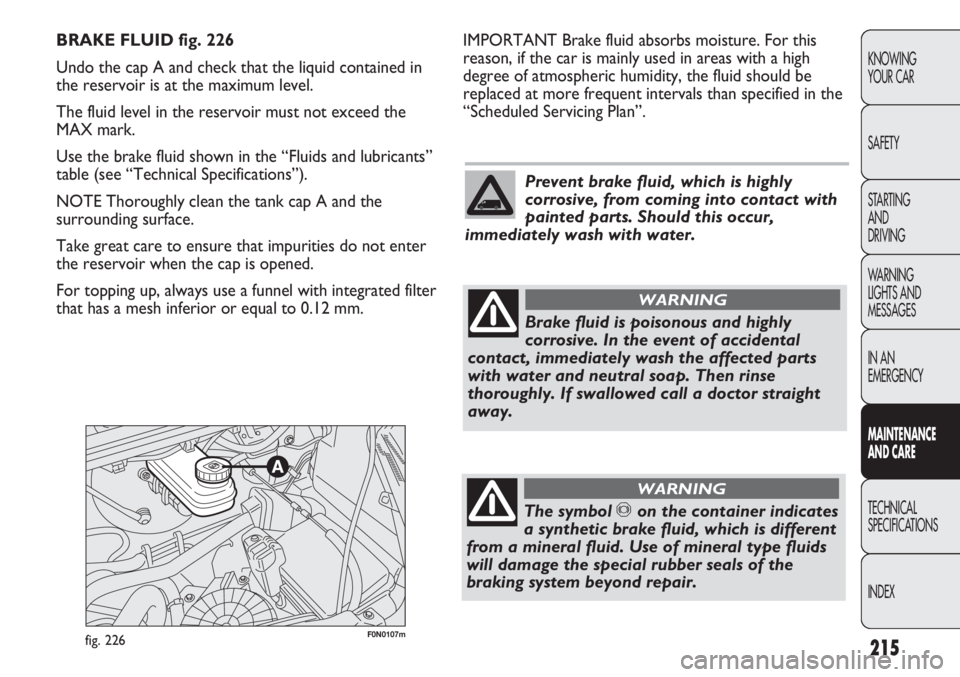
215
KNOWING
YOUR CAR
SAFETY
STARTING
AND
DRIVING
WARNING
LIGHTS AND
MESSAGES
IN AN
EMERGENCY
MAINTENANCE
AND CARE
TECHNICAL
SPECIFICATIONS
INDEX
F0N0107mfig. 226
IMPORTANT Brake fluid absorbs moisture. For this
reason, if the car is mainly used in areas with a high
degree of atmospheric humidity, the fluid should be
replaced at more frequent intervals than specified in the
“Scheduled Servicing Plan”. BRAKE FLUID fig. 226
Undo the cap A and check that the liquid contained in
the reservoir is at the maximum level.
The fluid level in the reservoir must not exceed the
MAX mark.
Use the brake fluid shown in the “Fluids and lubricants”
table (see “Technical Specifications”).
NOTE Thoroughly clean the tank cap A and the
surrounding surface.
Take great care to ensure that impurities do not enter
the reservoir when the cap is opened.
For topping up, always use a funnel with integrated filter
that has a mesh inferior or equal to 0.12 mm.
Prevent brake fluid, which is highly
corrosive, from coming into contact with
painted parts. Should this occur,
immediately wash with water.
Brake fluid is poisonous and highly
corrosive. In the event of accidental
contact, immediately wash the affected parts
with water and neutral soap. Then rinse
thoroughly. If swallowed call a doctor straight
away.
WARNING
The symbol ПЂon the container indicates
a synthetic brake fluid, which is different
from a mineral fluid. Use of mineral type fluids
will damage the special rubber seals of the
braking system beyond repair.
WARNING
Page 220 of 287
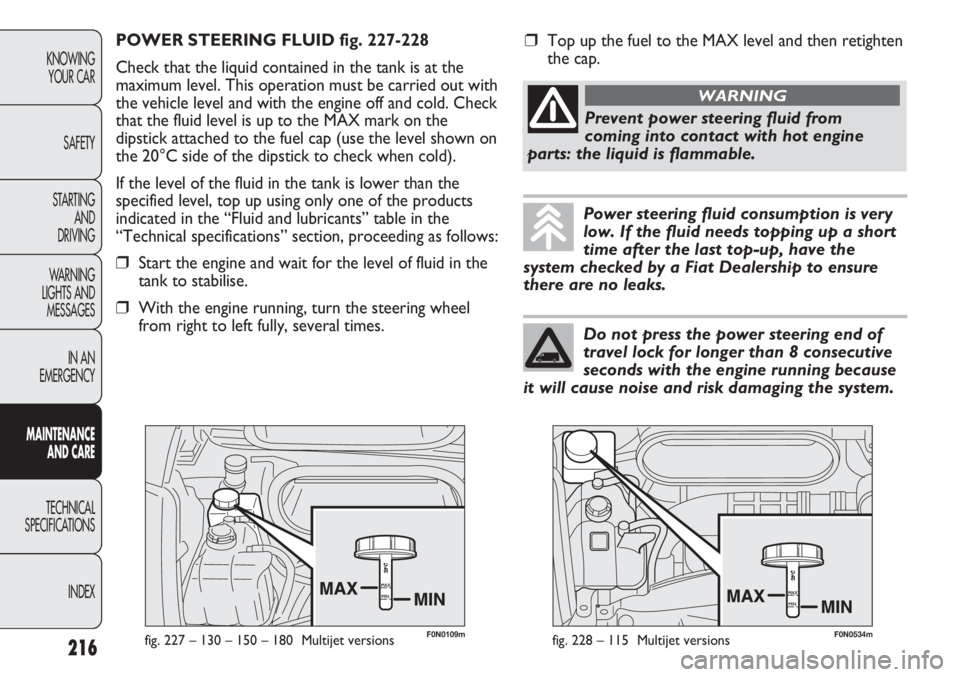
F0N0109mfig. 227 – 130 – 150 – 180 Multijet versions
POWER STEERING FLUID fig. 227-228
Check that the liquid contained in the tank is at the
maximum level. This operation must be carried out with
the vehicle level and with the engine off and cold. Check
that the fluid level is up to the MAX mark on the
dipstick attached to the fuel cap (use the level shown on
the 20В°C side of the dipstick to check when cold).
If the level of the fluid in the tank is lower than the
specified level, top up using only one of the products
indicated in the “Fluid and lubricants” table in the
“Technical specifications” section, proceeding as follows:
вќ’Start the engine and wait for the level of fluid in the
tank to stabilise.
вќ’With the engine running, turn the steering wheel
from right to left fully, several times.
216
KNOWING
YOUR CAR
SAFETY
STARTING
AND
DRIVING
WARNING
LIGHTS AND
MESSAGES
IN AN
EMERGENCY
MAINTENANCE
AND CARE
TECHNICAL
SPECIFICATIONS
INDEX
Power steering fluid consumption is very
low. If the fluid needs topping up a short
time after the last top-up, have the
system checked by a Fiat Dealership to ensure
there are no leaks.
Do not press the power steering end of
travel lock for longer than 8 consecutive
seconds with the engine running because
it will cause noise and risk damaging the system.
вќ’Top up the fuel to the MAX level and then retighten
the cap.
Prevent power steering fluid from
coming into contact with hot engine
parts: the liquid is flammable.
WARNING
F0N0534mfig. 228 – 115 Multijet versions